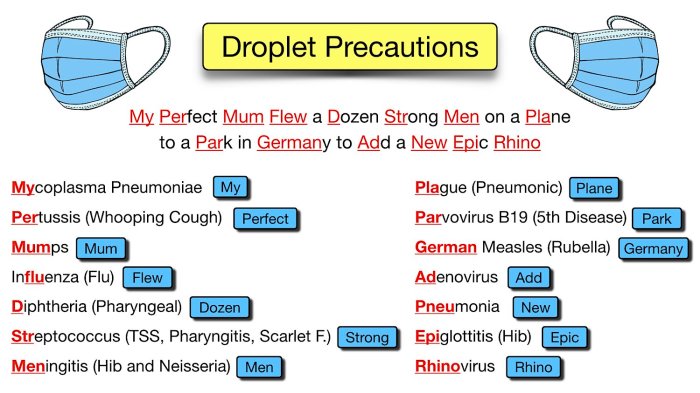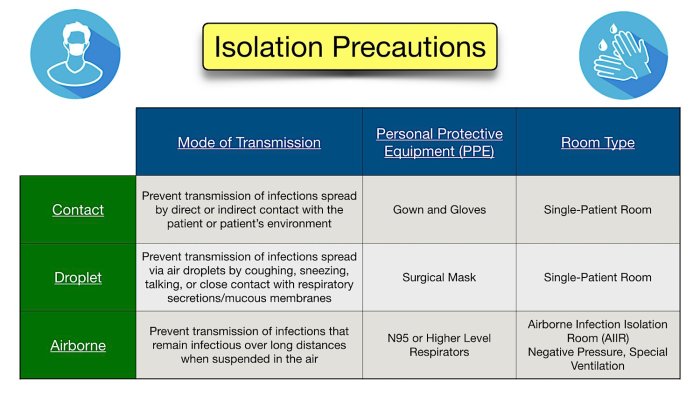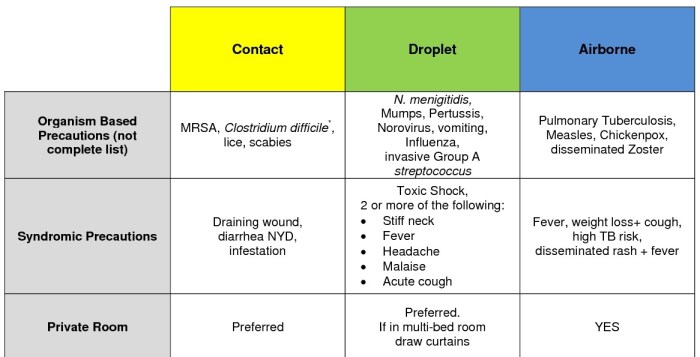Isolation precautions nclex cheat sheet – Welcome to the ultimate guide to isolation precautions for the NCLEX exam. This comprehensive cheat sheet will provide you with everything you need to know about isolation precautions, including definitions, purposes, types, and strategies for answering NCLEX questions.
Understanding isolation precautions is crucial for ensuring patient safety and preventing the spread of infection in healthcare settings. This cheat sheet will empower you with the knowledge and skills necessary to implement effective isolation measures and protect both patients and healthcare professionals.
Isolation Precautions

Isolation precautions are infection control measures used to prevent the spread of infectious diseases in healthcare settings. They aim to create a barrier between infected patients and others to minimize the risk of transmission.
The purpose of isolation precautions is to protect healthcare workers, patients, and visitors from exposure to infectious agents. By isolating infected individuals, the spread of the infection can be contained, and the risk of further transmission can be reduced.
Types of Isolation Precautions, Isolation precautions nclex cheat sheet
- Contact Precautions:Used for infections that are spread through direct or indirect contact with an infected person or their body fluids (e.g., MRSA, C. difficile).
- Droplet Precautions:Used for infections that are spread through respiratory droplets (e.g., influenza, pertussis).
- Airborne Precautions:Used for infections that are spread through small particles that can remain suspended in the air for long periods (e.g., measles, tuberculosis).
- Transmission-Based Precautions:Used for infections that can be spread through multiple routes (e.g., COVID-19).
NCLEX Cheat Sheet: Isolation Precautions Nclex Cheat Sheet

| Isolation Precaution | NCLEX Question Stem |
|---|---|
| Contact Precautions | The nurse is caring for a patient with MRSA. Which isolation precautions should be implemented? |
| Droplet Precautions | The patient has a suspected case of influenza. What type of isolation precautions are indicated? |
| Airborne Precautions | The patient is diagnosed with tuberculosis. Which isolation precautions are necessary? |
| Transmission-Based Precautions | The patient is infected with COVID-19. Which isolation precautions should be used? |
Strategies for Answering NCLEX Questions about Isolation Precautions:
- Read the question carefully and identify the type of isolation precautions being asked about.
- Recall the characteristics of each type of isolation precautions (e.g., mode of transmission, symptoms).
- Apply your knowledge to the scenario presented in the question and select the most appropriate answer.
Additional Resources

- Centers for Disease Control and Prevention: Isolation Precautions
- World Health Organization: Infection Prevention and Control: Isolation Precautions
- The Importance of Isolation Precautions in Preventing the Spread of Infectious Diseases in Healthcare Settings
Tips for Studying Isolation Precautions Effectively:
- Review the different types of isolation precautions and their corresponding modes of transmission.
- Practice applying isolation precautions to different patient scenarios.
- Use online resources and practice questions to test your understanding.
FAQ Section
What are the different types of isolation precautions?
The most common types of isolation precautions include contact precautions, droplet precautions, airborne precautions, and protective environment precautions.
How do I implement contact precautions?
Contact precautions involve wearing gloves and a gown when entering the patient’s room, and washing hands thoroughly before and after contact with the patient or their environment.
What are the key strategies for answering NCLEX questions about isolation precautions?
Focus on understanding the rationale behind isolation precautions, identify the type of isolation required based on the patient’s condition, and prioritize patient safety in all scenarios.

